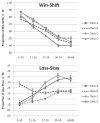Performance on the Iowa Gambling Task: From 5 to 89 years of age
- PMID: 24512562
- PMCID: PMC4115037
- DOI: 10.1037/a0035823
Performance on the Iowa Gambling Task: From 5 to 89 years of age
Abstract
The present study focuses on the role of frequency bias and expected value on the learning processes driving performance on the Iowa Gambling Task (IGT) in individuals between 5 and 89 years of age. As in previous studies, children performed poorly on the IGT, were increasingly influenced by frequency of losses during learning, and constantly changed their decisions. Decision-making strategies changed after childhood from erratic behavior to more consistent strategies that promoted expected value of deck choices. Performance deficits as well as a loss frequency bias were found in older adults. However, age-related deficits were distinct between children and older adults. Cognitive modeling analysis indicated that older adults were more likely to forget about recent outcomes and were more consistent than children when selecting decks. Cognitive ability was associated with a modeling parameter for memory as well as IGT performance, suggesting the involvement of a cognitive component in young and middle-aged adult decision making. The interactions of modeling parameters suggested that cognitive changes were the cause of lowered performance in older adults. These analyses suggest critical developments in decision processes during the adolescent years and decline in a cognitive process leading to decision-making deficits after age 60.
PsycINFO Database Record (c) 2014 APA, all rights reserved.
Conflict of interest statement
There are no conflicts of interest.
Figures




References
-
- Bechara A. Iowa Gambling Task professional manual. Lutz, FL: Psychological Assessment Resources; 2007.
Publication types
MeSH terms
Grants and funding
LinkOut - more resources
Full Text Sources
Other Literature Sources
Medical
Research Materials

